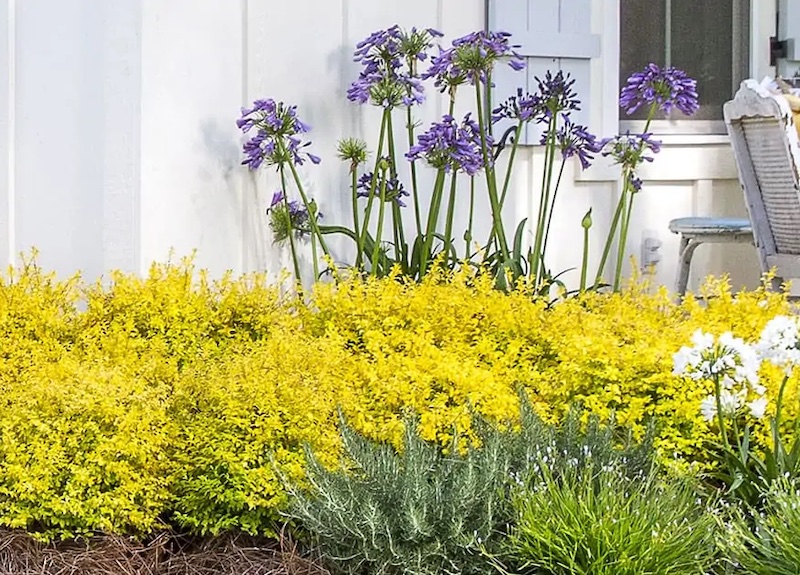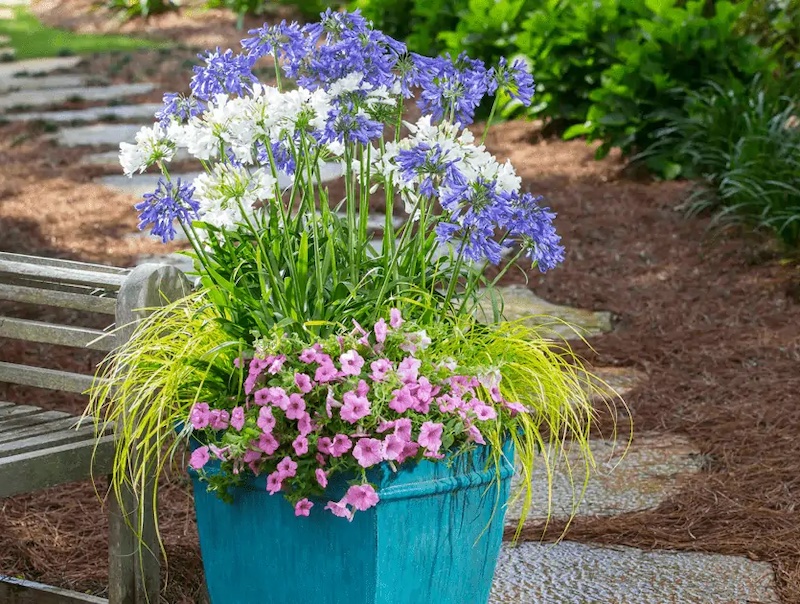The perennial bulb Agapanthus is only fully hardy in USDA zones 8-11, where they spread reliably and grow as semi-evergreen perennials. The large strappy leaves and nodding flowerheads stand out and give a tropical flavor. The deep blues, whites, and periwinkles of the flowers work seamlessly with calm pastels or hot, bright color themes.
Often Agapanthus is grown in containers as part of a seasonal display or as a means to overwinter it indoors in colder climates. Agapanthus also works well in a foundation planting, in a mixed perennial and shrub border, or in a designated Mediterranean or tropical bed.
Agapanthus have a shorter bloom time than other tropical plants, although the plant remains attractive for many months. When planning a planting with Agapanthus, keep in mind that this bulb blooms best when it is slightly root-bound, and most varieties will be quite large before they need dividing.
Container-grown Agapanthus can often live happily in a pot for many years before it requires dividing and repotting, making them some of the lowest maintenance plants.

Shrubs To Plant With Agapanthus
Planting agapanthus in front of taller growing shrubs is a great way to get a layered look. Some shrubs such as roses, hydrangeas, and butterfly bushes may flower toward the top of shrub, depending on how they are pruned. Using facer plants like Agapanthus will help to disguise leggy growth and elevate the design. Broadleaf evergreens such as privet, bay leaf, bayberry, and nandina also make great backdrops for the dramatic foliage of agapanthus. The colorful foliage of these shrubs can be used to complement or contrast the medium green agapanthus leaves.
Perennials To Plant With Agapanthus
Agapanthus mixes well with a wide range of hardy and tender perennials. Because agapanthus grows best in USDA zones 8-11, many of the plants native to the Mediterranean are ideal partners. Thyme, artemisia, sea holly, lamb’s ear, rosemary, and cistus rockrose can be mixed and matched to design a low-maintenance and water-wise space. All of the plants are drought tolerant once established and enjoy full sun. Salvia, mums, asters, sedum, and ornamental grasses are great for extending the blooming season of any border well into the fall and pair well with Agapanthus.
Annuals To Plant With Agapanthus
Agapanthus benefits from a living mulch of annual plants used as ground cover. Both large and small-leaved types of dusty miller, alyssum, calibrachoa, and sun-loving New Guinea impatiens grow large enough to stand up to the large Agapanthus leaves and will add a contrasting layer of color and texture. Taller annuals mix nicely with Agapanthus to provide color in the garden bed up to the first frost in fall. Cosmos, zinnias, sunflowers, and snapdragons provide sturdy height that rarely flops and contrasts the strappy form of Agapanthus.
Best Companion Plants For Agapanthus in Containers
Container companions should have a strong enough presence to compete with Agapanthus’ masses of strappy leaves that will be on display for most of the summer. Calibrachoa, petunias, licorice plants, and supertunias make great fillers and spillers and will contrast the vertical agapanthus flower heads when they are in bloom.
Agapanthus does not require heavy fertilizing to grow well in a container, but will grow best when given a light feeding with a diluted liquid fertilizer such as seaweed or fish emulsion. Feeding once a month from April to September is generally sufficient for Agapanthus and most container plants.

Plants Not To Grow With Agapanthus
Full sun and well-draining soil are two basic requirements to keep Agapanthus thriving in the garden. Planting Agapanthus in shade alongside ferns, bleeding hearts, hostas, or fuchsia will limit the blooming and growth of Agapanthus. Soils that retain moisture and are prone to flooding will cause Agapanthus to rot. Like other perennial bulbs, Agapanthus is more prone to rotting in the winter if drainage does not remain adequate year-round.
Best Plants To Grow With Agapanthus
Agapanthus looks best when paired with plants that have equally strong shapes and vertical interest. Asiatic lilies, alliums, cosmos, zinnias, and ornamental grasses are all effective companions when using Agapanthus as the focal point or an accent. Also, ensure that any companion plant thrives in full sun to part shade, and tolerates moderately moist soil with excellent drainage year-round. This is an unusual but highly rewarding plant to include in your plantings.
 |
Author Robbin Small - Published 9-27-2023 |




